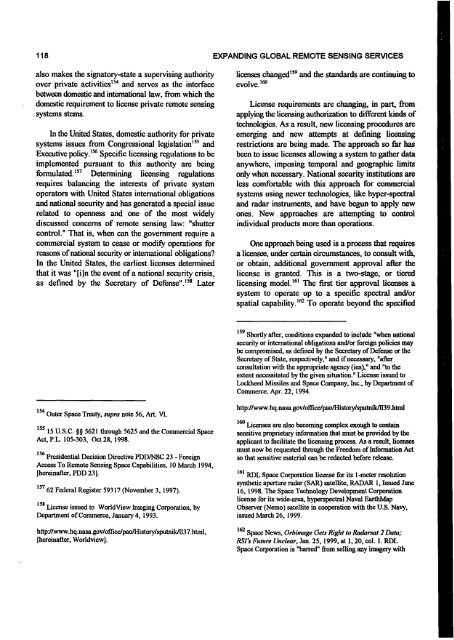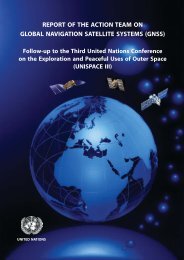Proceedings of the Workshop - United Nations Office for Outer ...
Proceedings of the Workshop - United Nations Office for Outer ...
Proceedings of the Workshop - United Nations Office for Outer ...
- No tags were found...
Create successful ePaper yourself
Turn your PDF publications into a flip-book with our unique Google optimized e-Paper software.
118 EXPANDING GLOBAL REMOTE SENSING SERVICESalso makes <strong>the</strong> signatory-state a supervising authorityover private activities154 and serves as <strong>the</strong> interfacebetween domestic and international law, from which <strong>the</strong>domestic requirement to license private remote sensingsystems stems.In <strong>the</strong> <strong>United</strong> States, domestic authority <strong>for</strong> privatesystems issues from Congressional legislation155 andExecutive policy.156 Specific licensing regulations to beimplemented pursuant to this authority are being<strong>for</strong>mulated.157 Determining licensing regulationsrequires balancing <strong>the</strong> interests <strong>of</strong> private systemoperators with <strong>United</strong> States international obligationsand national security and has generated a special issuerelated to openness and one <strong>of</strong> <strong>the</strong> most widelydiscussed concerns <strong>of</strong> remote sensing law: "shuttercontrol." That is, when can <strong>the</strong> government require acommercial system to cease or modify operations <strong>for</strong>reasons <strong>of</strong> national security or international obligations?In <strong>the</strong> <strong>United</strong> States, <strong>the</strong> earliest licenses determinedthat it was "[i]n <strong>the</strong> event <strong>of</strong> a national security crisis,as defined by <strong>the</strong> Secretary <strong>of</strong> Defense".158 Laterlicenses changed159 and <strong>the</strong> standards are continuing toevolve.160License requirements are changing, in part, fromapplying <strong>the</strong> licensing authorization to different kinds <strong>of</strong>technologies. As a result, new licensing procedures areemerging and new attempts at defining licensingrestrictions are being made. The approach so far hasbeen to issue licenses allowing a system to ga<strong>the</strong>r dataanywhere, imposing temporal and geographic limitsonly when necessary. National security institutions areless com<strong>for</strong>table with this approach <strong>for</strong> commercialsystems using newer technologies, like hyper-spectraland radar instruments, and have begun to apply newones. New approaches are attempting to controlindividual products more than operations.One approach being used is a process that requiresa licensee, under certain circumstances, to consult with,or obtain, additional government approval after <strong>the</strong>license is granted. This is a two-stage, or tieredlicensing model.161 The first tier approval licenses asystem to operate up to a specific spectral and/orspatial capability.162 To operate beyond <strong>the</strong> specified159 Shortly after, conditions expanded to include "when nationalsecurity or international obligations and/or <strong>for</strong>eign policies maybe compromised, as defined by <strong>the</strong> Secretary <strong>of</strong> Defense or <strong>the</strong>Secretary <strong>of</strong> State, respectively," and if necessary, "afterconsultation with <strong>the</strong> appropriate agency (ies)," and "to <strong>the</strong>extent necessitated by <strong>the</strong> given situation." License issued toLockheed Missiles and Space Company, Inc., by Department <strong>of</strong>Commerce, Apr. 22, 1994.154 <strong>Outer</strong> Space Treaty, supra note 56, Art. VI.155 15 U.S.C. §§ 5621 through 5625 and <strong>the</strong> Commercial SpaceAct, P.L. 105-303, Oct 28, 1998.156 Presidential Decision Directive PDD/NSC 23 - ForeignAccess To Remote Sensing Space Capabilities, 10 March 1994,[hereinafter, PDD 23].157 62 Federal Register 59317 (November 3, 1997).158 License issued to WorldView Imaging Corporation, byDepartment <strong>of</strong> Commerce, January 4, 1993.http://www.hq.nasa.gov/<strong>of</strong>f ice/pao/History/sputnik/II37.html,[hereinafter, Worldview].http://www.hq.nasa.gov/<strong>of</strong>fice/pao/Histoiy/sputnik/II39.html160 Licenses are also becoming complex enough to containsensitive proprietary in<strong>for</strong>mation that must be provided by <strong>the</strong>applicant to facilitate <strong>the</strong> licensing process. As a result, licensesmust now be requested through <strong>the</strong> Freedom <strong>of</strong> In<strong>for</strong>mation Actso that sensitive material can be redacted be<strong>for</strong>e release.161 RDL Space Corporation license <strong>for</strong> its 1-meter resolutionsyn<strong>the</strong>tic aperture radar (SAR) satellite, RADAR 1, Issued June16, 1998. The Space Technology Development Corporationlicense <strong>for</strong> its wide-area, hyperspectral Naval EarthMapObserver (Nemo) satellite in cooperation with <strong>the</strong> U.S. Navy,issued March 26, 1999.162 Space News, Orbimage Gets Right to Radarsat 2 Data;RSI's Future Unclear, Jan. 25, 1999, at 1,20, col. 1. RDLSpace Corporation is "barred" from selling any imagery with
















